Case Study 3: Woodland Caribou
Background

This case study explores the management of Alberta’s woodland caribou (henceforth caribou; Figs. 11.9 and 11.10). As in most other provinces, caribou herds in Alberta experienced significant population declines and range contraction during the twentieth century. The fundamental causes of these declines and the management steps needed to recover the species were well established by the 1980s (Edmonds 1988). Overhunting and harsh winters were believed to be the initial causes, but later declines were attributed to the progressive industrialization of the forest (Edmonds 1988):
Extensive timber harvest since the late 1950s has altered large areas of once occupied caribou habitat in west-central Alberta. Habitat of early successional stages developed, allowing for an increase in numbers and distribution of moose and, to a lesser extent, elk and deer. This increased prey base would, in turn, support a larger and more stable wolf population. Predation was the primary factor limiting the growth of caribou herds in our study area. … Unless immediate, intensive management is applied, caribou numbers and distribution in Alberta will continue to shrink. (pp. 825–826)
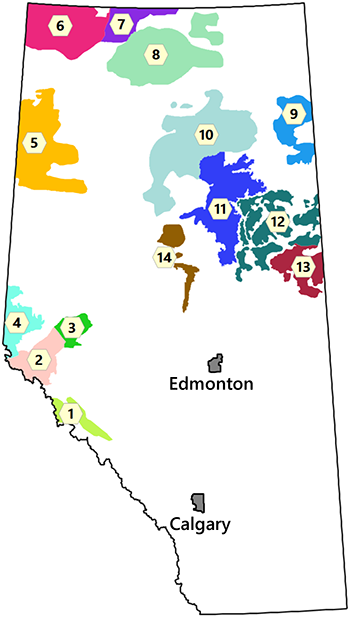
Industrial development also reduced the availability of preferred habitat and it facilitated human access into caribou range, which led to increased hunting, poaching, and vehicle collisions. The province’s initial response was to curtail the sport hunting of caribou, in 1981, and to designate the species as threatened, in 1985. Wildlife managers also recommended habitat protection, a short-term wolf reduction program, law enforcement, and public education (Edmonds 1988).
Recovery efforts during the 1980s were led by provincial wildlife managers, who had little authority over the decisions that mattered. While these managers were recommending habitat protection, other branches of government were allocating vast tracts of caribou habitat for new industrial developments (as recounted in Case Study 1). Managers were able to achieve minor adjustments to harvest plans, such as the temporary avoidance of old-growth stands. But they had no success in permanently protecting habitat or reducing timber harvest rates (Hervieux et al. 1996). The proposed wolf control program was abandoned because of public opposition.
The 1990s saw the advent of stakeholder-based decision making, following the nation-wide trend that began after the War in the Woods (see Chapter 2). Caribou committees and working groups were established at the provincial, regional, and range levels. The stakeholders within these groups were roughly divided into two camps: those who sought substantive protective measures for caribou (government wildlife managers, conservation groups, and Indigenous people) and those who favoured the status quo (most resource companies and local communities). Unsurprisingly, these two camps could not find common ground. Moreover, elected officials were unwilling to intervene. This was during the period of laissez-faire land management discussed in the previous case study.
The ensuing period was characterized by relative stasis (except for caribou, which continued to decline). Every few years a new strategy or set of management guidelines would be released, but meaningful on-the-ground protection of caribou was not forthcoming (Hervieux et al. 1996). The only area of substantive progress was in research. The resource sector was unwilling to entertain constraints on development, but it was willing to provide funding for caribou field studies. There was a hope that such research would lead to win-win solutions that permitted resource extraction while also maintaining caribou. Research efforts could also be cited as evidence of conservation effort, offsetting the lack of demonstrable on-the-ground change.
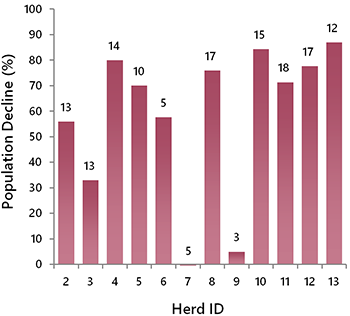
Some research efforts clarified range boundaries. Other studies quantified population trends, particularly for northern herds that had not been well studied prior to the 1980s (Fig. 11.11). Basic caribou biology, including habitat associations and requirements, was also studied. Finally, there was an effort to refine and quantify the causal mechanisms underlying caribou declines. Many millions of dollars were spent conducting this research, making caribou one of the most intensively studied of all Canadian species.
Triage
By the late 2000s, Alberta’s caribou were acknowledged to be among the most threatened in Canada (EC 2011). Nevertheless, caribou committees remained stalemated. The proponents of development, including some branches of government, were unwilling to accept that caribou and industry could not coexist and balked at substantive habitat protection measures. For their part, caribou advocates were adamant that all herds in all regions had to be maintained, and this remained the stated goal of caribou management strategies (GOA 2011). The objective of maintaining all herds had the effect of concentrating management attention on the most threatened herds, which were now at risk of near-term extirpation.
A research group at the University of Alberta argued that the impasse could only be resolved through a compromise approach that acknowledged certain realities (Schneider et al. 2010). First, it was time to accept that caribou could not be maintained through minor adjustments of industrial operating practices. Caribou were uniquely susceptible to disturbance at the regional scale through the predation-mediated mechanisms articulated by Edmonds in 1988 (quoted earlier) and later verified by many other researchers (Latham et al. 2011; Peters et al. 2013; MacNearney et al. 2016). The accumulated evidence indicated that long-term caribou persistence required near-pristine conditions. Second, the economic cost of curtailing resource development and reclaiming the industrial footprint in all existing caribou ranges was too high to be politically viable (Hebblewhite 2017). Several herds occupied lands that contained resources worth millions of dollars per square kilometre (Schneider et al. 2010). Third, by focusing management attention on the most endangered herds, opportunities for the protection of other more viable herds were being neglected, placing their long-term viability at risk as well.
The research group proposed that conservation triage should be explored as a management option. To this end, they conducted an analysis that ranked the caribou herds in terms of viability and cost of recovery (Schneider et al. 2010). The group did not try to determine the number of herds that should be protected, as this was seen to be a matter of social choice. But they did argue that conservation efforts (i.e., full habitat protection and reclamation) should be allocated in a way that achieved the greatest overall benefit for caribou at the provincial scale.
In a subsequent study, the research group used Marxan to identify the best options for caribou habitat protection at the provincial scale (Schneider et al. 2012). First, habitat was assessed in terms of risk factors to caribou persistence, including the intensity of the industrial footprint and the potential for habitat transitions due to climate change (Fig. 11.12a–b). Next, the cost of protection was determined, expressed as the monetary value of resources that would become inaccessible after protection (Fig. 11.12c). Finally, Marxan was used to identify planning units that achieved specified levels of caribou habitat protection while minimizing habitat risk factors and cost (Fig. 11.12d). As it turned out, the spatial distributions of cost and risk were broadly similar, so the trade-off between them was minimal (compare panels a–c in Fig. 11.12).
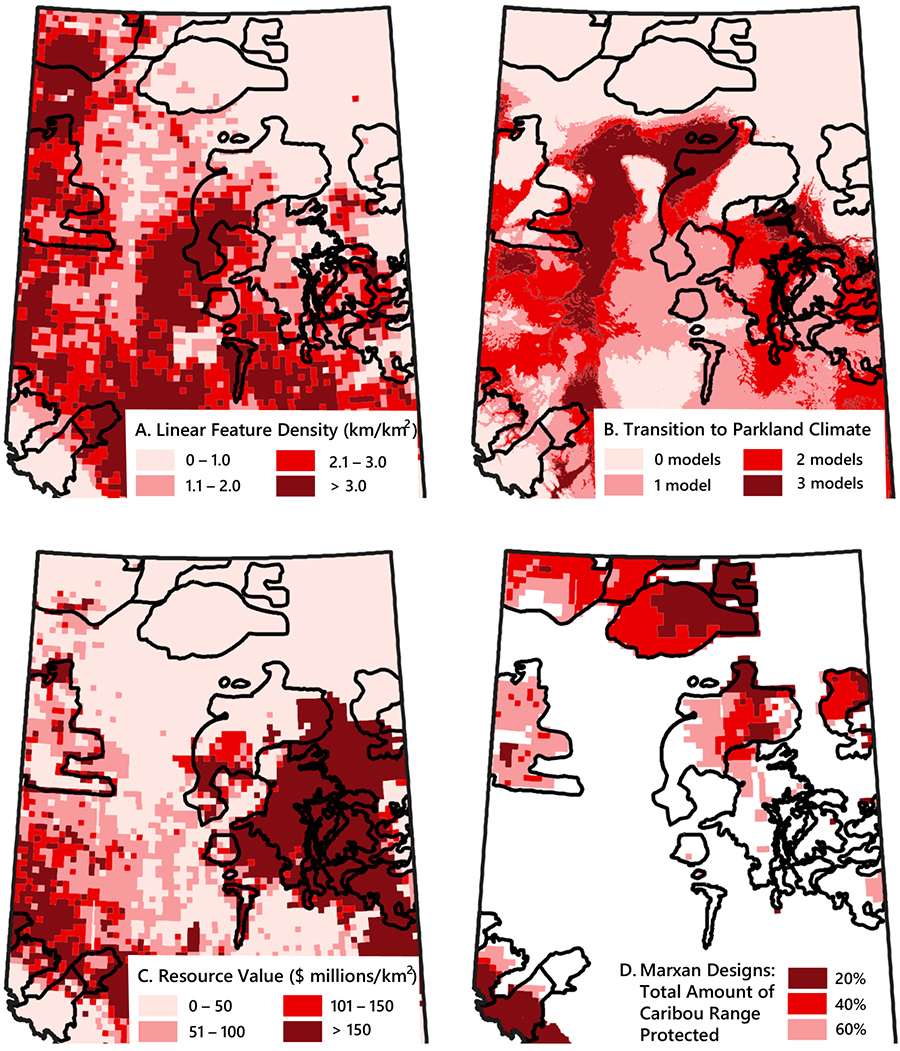
The researchers found that, using optimization, 60% of current caribou range could be fully protected (including 17% in existing parks) while maintaining access to over 98% of the value of resources on public lands (Schneider et al. 2012). This was possible because most of the resource value in northern Alberta is concentrated in oil and gas deposits that only partially overlap with caribou range. The overlap with forestry is greater; however, the value of forest products accounts for less than 1% of total resource values. The prospects for protection were much reduced if protection was instead directed toward the herds that were most endangered.
The release of the triage studies had no discernible effect on caribou management in Alberta. Critics saw triage simply as the abandonment of difficult herds. They questioned whether the quid pro quo of protection and reclamation of the more viable herds would actually happen. There was also a concern that genetic differences among herds would be lost. As for the government, the optics of triage were highly problematic. Politically, there is a world of difference between quietly allowing herds to decline through neglect and publicly announcing that certain herds will be abandoned in favour of resource development, even if other herds will receive enhanced protection as a result. There was also the federal Species at Risk Act (SARA) to contend with, as it provided no latitude for triage.
The Federal Recovery Strategy
The boreal population of woodland caribou in Canada was listed as threatened in 2003, when SARA came into force. Under SARA, a federal recovery strategy was required by 2008. However, by 2011, the strategy had still not been completed and a coalition of conservation and Indigenous groups mounted a court challenge to spur the federal government into action (Ecojustice 2012b). When a draft strategy was released later that year, the government was inundated with over 14,000 public comments—an indication of the species’ high profile (Paris 2012). The final strategy was released in 2012 (EC 2012c).
With the release of the federal recovery strategy, caribou management in Alberta (and other provinces) entered a new phase. Not only was the bar raised for recovery actions, but also, for the first time, these actions were non-discretionary.
The stated goal of the recovery strategy was to achieve self-sustaining local populations in all boreal caribou ranges throughout their current distribution in Canada. This goal effectively excluded triage as a management option. The justification for including all herds was that each herd contributed to population connectivity, redundancy, and the representation of local genetic adaptations, all of which are important for the long-term persistence of the species.
In terms of management actions, the recovery strategy was broadly similar to earlier strategies that had been developed in Alberta. It included habitat protection, wolf control, management of wolf prey species, voluntary restriction of Indigenous hunting, monitoring, and research. What differentiated the new federal strategy from all earlier efforts was the hard line it presented concerning the identification and management of critical habitat.
SARA defines critical habitat as “the habitat that is necessary for the survival or recovery of a listed wildlife species” (GOC 2002, Sec. 2). An expert panel, commissioned by the federal government, determined that the aspect of habitat which most affected caribou survival and recovery was the level of disturbance across the entire range (Fig. 11.13; EC 2011). For planning purposes, the panel developed a model that illustrated the relationship between total disturbance and the probability of maintaining stable or increasing population growth over a 20-year period (Fig. 11.14).
Following the expert panel’s lead, the recovery team defined critical habitat in functional terms: within each range, a minimum of 65% of the area would have to be maintained in an undisturbed state. The 65% undisturbed habitat target corresponded to a 60% probability of herd stability (Fig. 11.14), which was judged to be an acceptable level of risk. The planning team reasoned that a 100% probability of stability would have been ideal but unrealistic, since “0% total disturbance is virtually impossible even without anthropogenic disturbances” (EC 2012c, p. 66). The provinces were given until 2017 to develop range plans that would describe how the 65% target would be achieved for each herd.
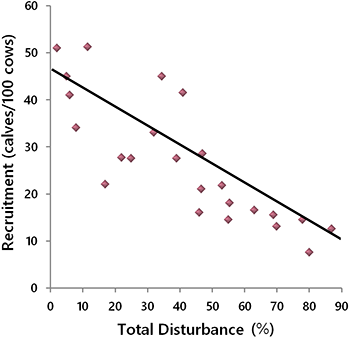 |
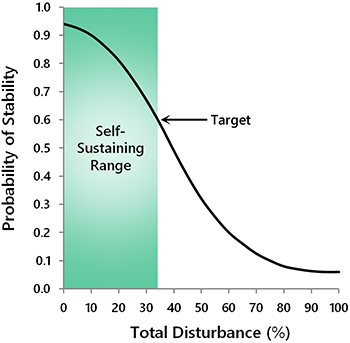 |
A subsequent federal policy document provided additional guidance for identifying and managing critical habitat for caribou (ECCC 2016c):
- Disturbed habitat includes areas of human disturbance, with a 500m buffer added around each disturbance, and areas that have burned within the previous 40 years, with no buffer
- In ranges with less than 65% undisturbed habitat, all currently undisturbed habitat should be protected from destruction
- In ranges with less than 65% undisturbed habitat, all areas possessing biophysical attributes for caribou should be protected from destruction
- In ranges with less than 65% undisturbed habitat, range plans should demonstrate how disturbed habitat will be restored to achieve the minimum 65% target, with timelines included
- Undisturbed habitat should be in contiguous tracts that facilitate connectivity
- Range plans should include a landscape management system that allows for ongoing disturbance (including fire) and renewal while ensuring that at least 65% of the area is always in an undisturbed state
- Range plans should identify the legally-binding instruments that will be used to prevent the destruction of critical habitat
The Alberta Range Plan
Alberta failed to complete individual range plans by the 2017 deadline. However, it did release a draft provincial range plan, which was meant to serve as a template for future herd-level planning (GOA 2017a). The draft range plan described how 65% of each range would be maintained in an undisturbed state through an integrated landscape management system. The centrepiece of the proposed system was a multi-use access network that would be developed for each range. According to the range plan, it would be possible, using spatial optimization techniques, to design a network that provided access to virtually all resources while still achieving the 65% caribou target.
The range plan also included aggregated forest harvesting, which we previously encountered in the Al-Pac case study. By concentrating harvesting in a specific area over a ten-year period, and then moving on to a new area, the overall level of disturbance on the landscape would be reduced (Fig. 11.15). The range plan contained no mention of altering annual forest harvest rates.

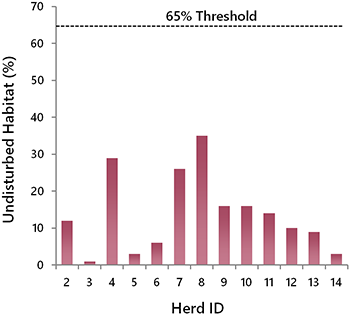
The range plan acknowledged that achieving the 65% undisturbed target would require restoration efforts because existing levels of disturbance were very high in all ranges (Fig. 11.16). Under the range plan, restoration would be applied to industrial features that were no longer in use, particularly seismic lines and well sites. In addition, access routes would gradually be transitioned to the new optimized network. Given the extent of the existing footprint, it was estimated that it could take 50–100 years to achieve the 65% undisturbed target in all ranges (GOA 2017a).
The range plan also included measures for maintaining the viability of herds during the extended restoration period. The primary measure was wolf control, which was already being used in the highly compromised Little Smoky range (Herd 3 in Fig. 11.10; Hervieux et al. 2014). Additional proposed measures included the establishment of predator-free enclosures for calf-rearing and increased hunting of moose, deer, and elk to reduce prey availability for wolves.
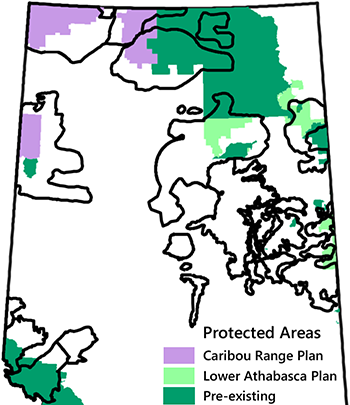
Finally, the range plan included protected areas as a recovery measure. Existing protected areas that overlapped with caribou range were incorporated, and the plan identified several new candidate reserves (Fig. 11.17). The new reserves were mainly the portions of caribou ranges that were undeveloped and held minimal resource value (Denhoff 2016). There was substantial overlap with the priority sites identified under the triage approach (compare Fig. 11.17 with Fig. 11.12d).
The planners did not anticipate opposition to the new protected areas. The resource potential of the proposed reserves was inconsequential when compared with most other parts of northern Alberta (Fig. 11.12c). No forest tenure was affected (by design) and the few existing oil and gas leases were to be grandfathered in (Denhoff 2016).
Local communities saw things differently. Grand provincial-scale trade-offs and relative resource values were not of interest to them. As they saw it, their prospects for growth were being unfairly constrained. A municipal committee in northwest Alberta was formed and it delivered a petition to the Alberta government containing over 9,000 signatures—approximately 50% of the regional adult population. They asked the government to “forgo any type of additional permanent conservation land designation” (NWSAR 2016). They also requested that a comprehensive socio-economic assessment be done.
The Alberta government found itself between the proverbial rock and a hard place. On one side were the vocal concerns of local communities, and on the other, the pressing demands of SARA and the public supporters of caribou conservation. The Alberta government’s response was to send a letter to the federal government, in early 2018, indicating that additional time and an infusion of federal funds would be needed to advance caribou recovery in the province. The letter also laid out a clear challenge to the federal government: “Alberta’s approach to protecting caribou populations and fulfilling the requirements under federal law cannot and will not come at the expense of our economy” (Phillips et al. 2018, p. 2).
As of this writing, the federal government has not indicated how far it will go in defending SARA. If it pushes too hard, Alberta will rebel. If it does not push hard enough, it will find itself in court for failing to uphold federal law. This is likely to be the major showdown over SARA that many have predicted since its inception in 2002.
Analysis and Conclusions
This case study features complex multi-tiered decision making. Wildlife managers knew decades ago that continued caribou declines were inevitable unless resource development was constrained. However, they had no authority over the decisions that mattered most, such as tenure allocations, harvest rates, and infrastructure planning. Stakeholder planning committees had no control over these decisions either, though this was perhaps moot since these committees were perpetually deadlocked.
So it was that the key decisions that determined the fate of caribou were not made deliberately by those responsible for managing caribou, but passively by other government departments pursuing the broader government agenda of economic development. Given the high profile of caribou, this cannot be considered an oversight. It was a conscious, if informal, decision by higher levels of government to prioritize economic development over caribou.
It was the federal government, through SARA, that ultimately forced Alberta to take substantive action to recover caribou. This is a good illustration of the difference between policy and law. The Alberta government had designated caribou as threatened in 1985 and had repeatedly committed to sustaining caribou in various policy documents. But there were no consequences when it failed to follow through on these commitments. In contrast, the directives of SARA carry the force of law and cannot be ignored, as the federal government has already learned through several successful court challenges.
Within the federal recovery strategy, the inclusion of a disturbance threshold was pivotal. This was one of the most important decisions made in the history of caribou conservation. For better or worse, it brought clarity to all parties about what caribou recovery would entail—it drew a line in the sand.
The choice of 65% undisturbed habitat as the management target was based on a blend of science and subjective judgment. The statistical relationship between habitat disturbance and caribou persistence provided an objective foundation for decision making. However, the selection of 65% as the breakpoint, corresponding to a 60% probability of persistence, was a subjective decision. It reflected the recovery team’s assessment of acceptable risk and perhaps their assessment of political feasibility. Such decisions tend to be attacked from all sides (too risky, too impractical), yet without them, nothing happens.
Another dimension of decision making highlighted by this case study concerns the rights of local communities with respect to public lands. As illustrated by the response of northern Albertans to the range plan, even marginal resources that do not currently support anyone’s livelihood can motivate forceful opposition to habitat protection by resource-dependent communities. Given their close relationship with the land, should these communities have a veto over conservation decisions? Or should SARA have the veto because it conveys the conservation goals of broader society? What about local Indigenous communities, which have their own perspectives and rights concerning land use? Clearly, some form of balance needs to be achieved, which leads us back to regional planning.
This case study also features an important ethical question: is it acceptable to kill one species (wolves) in order to save another (caribou)? Opinions are divided, even among conservationists. Certainly, the desire to forestall near-term extirpation is a compelling argument for taking extreme measures, including wolf control (Hervieux et al. 2014). However, opponents of wolf control argue that wolves are being killed mainly because of the government’s unwillingness to address the root causes of caribou declines, which relate to ongoing habitat degradation (Proulx et al. 2017). There is merit to both perspectives and the final decision is likely to be made in the court of public opinion.
Notably absent from the planning processes to date has been a formal assessment of socio-economic trade-offs. Under SARA, this aspect of conservation decision making is meant to be addressed at the action planning stage. However, the Alberta range plan did not include a socio-economic assessment.
The absence of socio-economic considerations in the Alberta range plan does not mean they have been overridden or are no longer important. The province’s strongly worded letter to the federal government makes it clear that caribou conservation will not come at the expense of the provincial economy. Moreover, the federal caribou recovery strategy makes allowances for economic contingencies: “Implementation of this strategy is subject to appropriations, priorities, and budgetary constraints of the participating jurisdictions and organizations” (EC 2012c, p. iv). Thus, planning remains incomplete—the economic cost of recovery is a shoe that has yet to drop.
We turn finally to an appraisal of what has been achieved through caribou recovery efforts to date. The short answer is: very little, other than research. The most significant achievement has been the development of the provincial caribou range plan which, for the first time, contains concrete management targets and a plan for achieving them. But in practical terms, the only reason caribou herds no longer face imminent extirpation in Alberta is that wolves are now being killed on a massive scale. Long-term recovery is still far from assured.
It remains to be seen if the range plan will be implemented as proposed. There are many technical challenges to be resolved and economic hurdles to be crossed. The federal government’s involvement and the legal weight of SARA should ensure that an earnest effort is made. But it is unclear how far the federal government will intervene if Alberta backtracks because of costs.
There are also concerns with the plan itself. The chosen disturbance target provides only a 60% probability of stability, which is far from reassuring. Furthermore, it is unclear whether achieving the habitat target will produce the expected outcomes. Everything hinges on a statistical relationship between disturbance and caribou recruitment that was based on a small number of coarse-scale observations. The reliability of this relationship when applied to fine-scale planning efforts is unknown.
The plan also includes several forms of unacknowledged risk. The decision to allow continued industrial disturbances within caribou ranges while restoration gets underway—in apparent contravention of federal policy—prolongs the entire recovery process, exposing caribou to increased risk. In addition, the plan does not take the effects of climate change into account. This is a critical oversight, given the virtual certainty that herds will have to shift their ranges northward as temperatures warm (Dawe and Boutin 2016). Disturbance management and restoration efforts should anticipate these range shifts by targeting both current and future caribou range. Finally, the plan makes no provisions for the future impacts of fire.
Given these risk factors, the odds are low that all herds will persist. This being the case, perhaps triage would have been best after all. However, there is an important counterargument to be considered. In their analysis, the proponents of triage failed to account for the broader biodiversity benefits of caribou conservation.
The Alberta range plan is, at heart, a cumulative effects management system that will benefit many species. In a roundabout way, it achieves what the Land-Use Framework initially set out to accomplish, which was to manage the total industrial footprint through integrated planning. Whether 65% undisturbed habitat is the appropriate target is an open question. But it is undoubtedly a good starting point. The upshot is that the range plan does the right thing for perhaps the wrong reason.
Caribou seem to have provided the focus and political momentum needed for managing cumulative effects. Perhaps the coarse-filter approach is just too abstract for high-level political decision making. It may be that a concrete issue, like caribou viability, is needed. But there are also drawbacks to a single-species approach. Caribou, while wide-ranging, are not found everywhere. Moreover, they actively avoid many habitat types as a consequence of their predator avoidance strategy. The high vulnerability of many herds also raises an important question: what happens to conservation if a herd is extirpated? Similarly, what happens if a herd shifts its range because of climate change?
These concerns could be resolved by extending the caribou range plan’s land management approach to the full working landscape. This is not inconceivable. If it can be shown that cumulative effects can be managed on caribou range without unacceptable economic repercussions, resistance to wider application may diminish.

